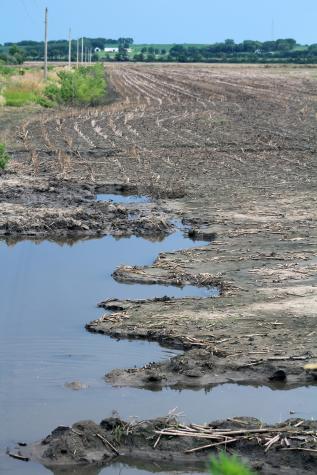Writer
Linda GeistCOLUMBIA, Mo. – Lessons from past floods tell how to bring flooded fields back into production, says Kent Shannon, University of Missouri agricultural engineering specialist.
Shannon says there are three stages to repairing flood-damaged fields.
1. Remove debris and sediment
Burn plant material such as cornstalks and trees on the land where they were found. Bury ashes there also.
If cornstalks or other crop residues are not too deep, mix into soil with normal tillage.
"Do not till when the soil is too wet. This will cause compaction and create more of a problem," says Shannon. "Also, burying high-carbon crop residues may temporarily tie up nitrogen in the soil as microbes break it down."
Most approved Missouri landfills will accept other debris such as tires, posts, boards, propane tanks and appliances. See guidelines from the Missouri Department of Natural Resources at https://dnr.mo.gov/disaster-resources or contact the nearest Missouri DNR office.
Soil sediment from floods poses additional challenges for crop production. Texture of the deposited soils differs from unflooded soils. Depth of deposits determines how to handle it.
- 0-2 inches: mix with normal tillage operations.
- 2-8 inches: mix with chisel or moldboard plow.
- More than 8 inches: spread or remove to a depth of 8 inches or less and combine as above.
Till 2.5 times the depth of the sand. For example, one would till 10 inches deep for 4 inches of sand (4 x 2.5 = 10), says Shannon. Avoid tillage or other field work until soil dries enough to reduce the chance of compaction.
2. Repair erosion
The degree of erosion can vary from a few inches to many feet. Manage levels based upon depth.
- Tillage. Till when you can smooth soil and farm it after normal tilling.
- Earth moving. Do this if erosion is too deep to correct with tillage. Fill, then farm. Fill eroded areas or top dress with native soil from other parts of the field, depending on depth of erosion.
- Abandonment. Sometimes you may need to abandon some land. This happens when erosion is too deep to correct economically.
If using sediment to fill eroded areas, use native soil from another area in the field for the final 3 feet to avoid droughty areas.
Always avoid fieldwork until soil is dry enough to reduce the chances of compaction, says Shannon. After major repairs, sample the soil in the repaired area. Consider sampling from repaired areas and undisturbed areas to decide how to handle each part. To lessen the risk of compaction, do not drive on the same areas of the field when making repairs .
3. Manage other factors
Soil crusting occurs when surface soil texture hardens. This can look like compaction. Crusting can keep roots and water from getting into soils. Tillage should fix a shallow crust (less than 2 inches).
Risk of wind erosion increases when crop residue washes away. Reduce wind erosion by seeding a cover crop as soon as conditions permit, says Shannon.
There are several options for seeding cover crops:
- Aerial seeding success depends on timely rains and may not be as effective as other options because of a lack of seed-to-soil contact. However, aerial seeding allows the earliest seeding on the entire field at one time when it may not be possible to get in the field by ground.
- Broadcast seeding followed by light tillage offers better seed-to-soil contact, but field conditions must be right to seed the whole field at the same time.
- Drilling gives the best seed-to-soil contact and seed distribution, leading to quicker germination and establishment. Drills may provide some soil smoothing and cause less compaction than tillage to incorporate seeds.
Other crop management practices
Many other decisions, such as tillage, fertility recommendations, cover crop termination, inoculation, seeding practices and weed control, may require special consideration after a flood.
For more information, contact your county MU Extension center.
This article includes information adapted from "Repairing Flood-Damaged Fields" by John Wilson, extension educator for the University of Nebraska-Lincoln, at https://cropwatch.unl.edu/2019/repairing-flood-damaged-fields.
Photo available for this release.
https://extension.missouri.edu/media/wysiwyg/Extensiondata/NewsAdmin/Photos/2019/holt-flood-land.jpg
University of Missouri Extension specialists say sand and scours are among the many challenges of repairing flood-damaged fields. Photo by Linda Geist.
